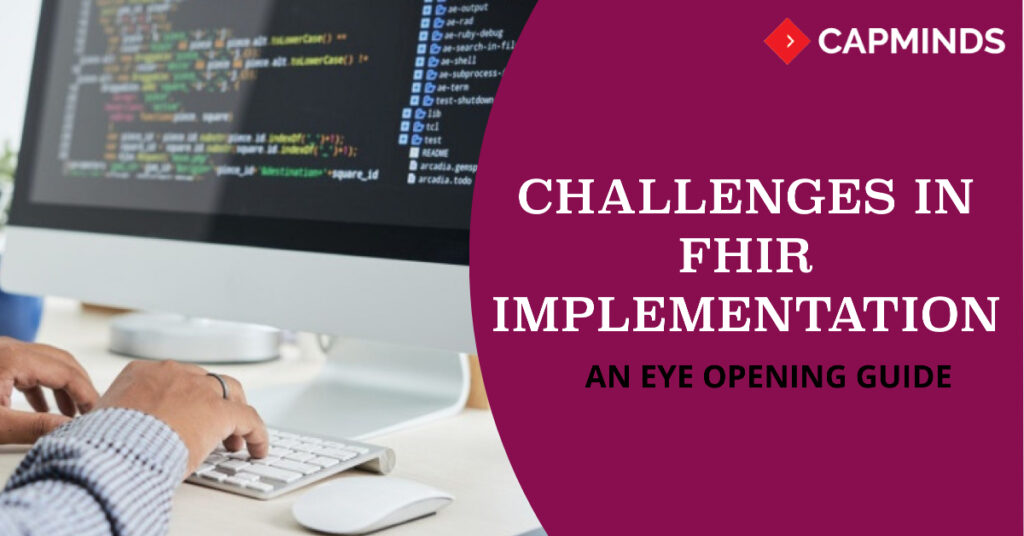Challenges In FHIR Implementation – An Eye Opening Guide
FHIR is an interoperability standard developed to exchange healthcare data and information electronically by HL7 — an international organization founded in 1987, dedicated to developing standards for electronic health information sharing. The main purpose behind the development is to address the growing digitization of the healthcare industry and the requirement to have patient records easily accessible, available, and understandable. In this article, we discuss the need for FHIR and its implementation challenges.
If you are aware of HL7 standards, then you also have heard how difficult to work with the HL7 standards are. The most common difficulty people come up with is, the way the standard was interpreted and implemented, which inhibited smooth data exchange and required additional translation layers. FHIR was created to overcome the above-said issues. Like every standard comes with its own advantages and limitations, so does FHIR. The adoption of FHIR has its own challenges.
Do you know how FHIR resources function?
FHIR is designed on the concept of ‘resources’ – the building blocks for all data exchanges. The resources need to be based majorly on JSON, XML, Atom, HTTP, or OAuth structure. The structure is as follows:
Resource Type — This resource type structure helps to Identify the specific resource model For example Patients, Medications, Allergies, etc.
Human Readable summary section — This is a type of XHTML section. It shows a human-readable version of the content within the message.
Identifier section — This holds a unique identifier URL for each resource identifying to be of a specific type e.g. Patient
Extension section — This section allows any extension that might be required to support specific clinical workflows e.g. clinical trial applicability. The extension section can be inserted in any of the sections to cover specific use cases and workflow needs
Contained Resources — In this section, the other resources used in identification and transaction processing will be available here. For example, the message header or images associated with the patient such as an avatar
Resource content — This section holds the core content of the resource. For example, if we consider the patient, it contains all the related details about that patient such as name, address, phone number, and other contact information.
Tags — The Security labels can include ACLs, workflow-specific functions, etc.
The Challenges of FHIR
1. The Adoption is going to be slow
Advancement of standards commonly starts with an excited group of volunteers however until FHIR® arrives at a degree of development, governments are not prone to compose it into guideline – and adoption is probably going to be slower. HL7 V3 was generally fruitful in the Netherlands, Canada, and England as the standard was utilized to help interoperable electronic medical records programs.
2. The cost of adoption
For a popular and large-sized organization adopting a great standard like FHIR, which covers a very wide scope, the issue often lies in matching your existing domain to the standard’s concepts. The internal domain model will differ from the standard the organizations trying to adopt.
Likewise, numerous health providers have put millions in financing and asset to build up their advanced development. FHIR® could upset the interoperability system where principles are now set up, delaying the realization of benefits.
3. Potential threats for vendors
Some IT vendors could be compromised by FHIR®’s capacity to shorten deployment times of significant frameworks like a common health record (through effortlessness and speed of usage) which in turn reduces revenue. The best Integration providers that promote speed and ease of deployment, such as CapMinds, are effectively encouraging FHIR® adoption to support transformation.
There are other inconsistencies that too happen when EHR vendors don’t implement all the current FHIR APIs and even in the situation, they do, then also they don’t implement the entire API. This inconsistency undermines the objective and purpose of achieving interoperability.
4. Absence of visible case studies
Health and care are a truly risk-averse industry and not many healthcare providers effectively advance development. The HL7 FHIR® community is extremely proactive in sharing best practices and FHIR® in action, however, these examples are sometimes not promoted more widely outside the FHIR® enthusiasts. Broader dissemination of FHIR® case studies to healthcare providers who embrace a ‘keep a watch out’ approach is imperative.
5. Absence of ownership
Regardless of its quick development, FHIR® is dependent on a network of groups creating it. The UK’s INTEROPen and France’s Interop’ Santé examples of proactive groups that are creating FHIR® guidelines for explicit use cases yet a more extensive guide isn’t set up to address comprehensive healthcare challenges.
The Right Strategy helps healthcare organizations for the Potential of FHIR
The healthcare industry stands to benefit by adopting the FHIR API. Federal compliance pressures may cause some short-term challenges, but organizations can ready themselves with an adoption strategy that looks beyond the initial push for compliance and accommodates complex use cases that require more partners, more connections, and likely more time.
RELATED
DON’T MISS THIS: 9 PROVEN IMPLEMENTATION BENEFITS OF FHIR
FHIR – The Best Choice To Improve Your Clinical Workflow
As the healthcare organization continues to drastically shift from fee-for-service to value-based care, data interoperability is increasingly becoming an important key for providers trying to better engage with patients, improve clinical workflow, and drive better health outcomes.
As the technologies are growing day by day to collect and store healthcare data, the ultimate challenge is to make these various sources of data—from patient portals, hospitals, clinicians, health plans, and patient portals effectively connect to one another. FHIR is one of the best ways to establish data source access standardization. FHIR saves a lot of the precious time of healthcare providers on the stressful process to access patient medical records and make recommendations that are always up-to-date and in line with current best practice standards.
Get started with CapMinds FHIR Services
The healthcare systems and healthcare technology vendors have to solve the common FHIR challenges in order to stay updated with these advanced standards and to maintain interoperability between health systems and healthcare technology solutions. CapMinds can help to solve these challenges and remove much of the time and cost burdens involved. Make use of the best FHIR implementation and support services offered by CapMinds to improve your clinical workflow.




